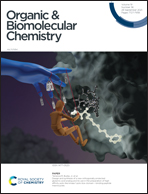A BODIPY-O-glycoside based near-infrared fluorescent sensor for serum albumin†
Abstract
Highly sensitive and selective near-infrared fluorescent bioprobes for serum albumin detection and quantification are in high demand for biomedical applications. Herein, we report a near-infrared emitting BODIPY-O-glycoside dye as a turn-on emission sensor for serum albumin. To the best of our knowledge, this is the first report of NIR-emitting BODIPY dyes for serum albumin sensing. Despite the various outstanding photophysical properties of the BODIPY dyes, their insolubility in water/biological media restricts their real biomedical applications. To overcome this issue, highly stable unadulterated BODIPY-O-glycoside nanoparticles (BDP-Glu-NPs) were prepared in aqueous solution by self-assembly of amphiphilic BODIPY-O-glycoside dyes. The BDP-Glu-NPs were characterized by spectroscopic, NMR, DLS and TEM studies. The ability of the BDP-Glu-NPs for the detection and quantification of serum albumin was demonstrated. It showed a 150-fold fluorescence enhancement in the presence of serum albumin, with excellent selectivity over other amino acids, porphyrin, proteins and various inorganic salts. Detection of human serum albumin (HSA) in urine samples showed that the bioprobe is applicable to a clinically significant range of the analytes with very low detection limit. These results suggested that the BDP-Glu-NPs can act as potential bioprobe to quantify albumin in biochemical and clinical samples.



 Please wait while we load your content...
Please wait while we load your content...